As mentioned in my last blogpost, my two weeks in Oaxaca were so full of new impressions, sights, and tastes that I couldn't pack it all into one write-up. One area that I completely omitted to mention is the fact that Oaxaca dates back more than 2,000 years, to the times of the Zapotecs who established the early civilization of Monte Alban, just a hop and a skip from today's metropolitan area. While I had already ridden once in the vicinity of the hilltop ruins when I visited the villages of San Andreas and San Pedro Ixtlahuaca and looped around the antique site, it wasn't until my second week that I made a special excursion to Monte Alban.
I had already found out before that, thanks to COVID-19, numerous churches and tourist attractions are currently closed, so I had checked the website to make sure that Monte Alban could be visited. So, when after a three-mile climb up to the ruins I was confronted with a barrier and two masked gatekeepers my disappointment was understandably profound. It turns out, that per day only 400 visitors are allowed, with no more than 100 at a time, and the day's quota had been met an hour before I got there at about 11:30 a.m. Rats! But, I am a reasonable and nice guy, so I involved the two young men in a conversation, reminding them what a hard climb it had been and how sad it would be if I couldn't finish the last half kilometer and at least catch a brief glimpse of the UNESCO World Heritage Site. And really, what was the difference between 399 and 400 and 401? And so they let me through...
I had visited Monte Alban 40 years ago, but my recollection was not of such a well-maintained and beautiful site. After locking up the Ritchey and paying my $4.00 entry fee I was able to roam around the ruins without the usual masses of tourists that get deposited by the bus-load. Actually, at the time that I arrived, most visitors appeared to have already left. Monte Alban is imposing: The early Zapotecs chose a hilltop that was suitable to accommodate a large city, with huge plazas and a layout that must have been a wonder of the world at that time (if it is not now as well). The view of the surrounding landscape, which then and now harbored small villages and their fields, is breathtaking. To the north spans the Sierra Madre, while to the south and west other ranges define the horizon. It was a fairly clear day, and I enjoyed just taking in the sights from up there.
The interpretive signage (in Spanish, English, and Mixtec) is thankfully rather limited—it's OK to learn when a particular structure was erected, what its purpose was, and what some of the main features were. I have a hard time remembering it all anyhow! I prefer to take in the ambiance of such a site, and if I want to learn more, there nowadays easy ways to do so. Hey Google!
Monte Alban is not the only major cultural monument in the area: Mitla, a city that is not quite as old as Monte Alban but still is old, is another major attraction. But it is about 35 miles north-east of Oaxaca, and when I looked at what it would take to ride there and back in a day, I decided to forego refreshing my memories. (I had visited Mitla, which by far is less spectacularly situated than Monte Alban, way back when; it has some amazing architectural features and is well-known for its intricate stone patterns. Still, I didn't feel an urge strong enough to forego a day of riding to get into a bus and possibly be told by a less lenient gatekeeper that the day's quota of visitors had already been met.)
Instead, I rode twice in the same general direction as Mitla, just not as far. On my first foray my goal was to see the world's (allegedly) largest tree in Santa Maria el Tule. El Árbol del Tule is a Montezuma Cypress that has a trunk girth of 42 meters (or almost 138 feet)! Now, that's big! According to Wikipedia the tree is about 1,500 years old, plus/minus a hundred or so. Thanks to COVID one cannot get too close to the tree or enter the accompanying church or grounds, but it's still a neat place to visit.
The other ride (which took me by El Tule) was actually my last excursion, and I really hadn't expected all that much. I used the suggestion of a website for a route to the small village of Teotilan de Valle, an attractive little place that lives of eco-tourism in the form of hiking and mountain biking, located at the foot of the Sierra Juarez. The ride took me over many gravel roads and tiny goat paths. I passed by agave fields (the region is well-known for its mezcal, of which I'm taking some home) and enjoyed tremendous vistas of the mountains. Maybe one of the most surprising moments of all of my rides arrived when, in the middle of truly nowhere, I came upon what I call the Cactus of Shame—an opuntia decked out with panties, bras, and blouses! I'd love to hear those stories...
Once I got to the top (a saddle after which the road started to dip farther into the Sierra) I spent a couple of pesos on the first Coke I have had in many, many years. I figured I could use that sugary kick. From here I still had a hundred or so vertical meters of climbing ahead of me, on the dirt road that I had mapped out, before the long plunge back down to finally reconnect with the paved road that had taken hours to conquer. Well, at least that was the plan. Initially the dirt road was well-packed and pleasant to ride, but then I missed a turnoff and had to backtrack for a few hundred feet. But that new road was less traveled, and then there was another turn-off, and now the road became a path and then less than a path and then there was a sign that showed that this path had been closed to mountain bikes. At that point I decided to backtrack, climb a few hundred meters back, and safely descend on the road that I had come up on. Altogether I climbed almost 2,000 meters that day. But boy, was it memorable! And I celebrated with some rather unusual (taste and size!) margaritas just about one kilometer from the house.
Needless to say, this trip also featured a little bit of beer culture. Thanks to the pandemic, several of the local breweries were temporarily closed, but nevertheless I managed to add three more cervecerias artesanales to my list, which is rapidly closing in on 350 microbreweries and taprooms. The beer was surprisingly good, even if only one of them featured my favorite, the IPA. But then, how often do you encounter agave beer? (Truth be told, it was a bit on the malty side for me, but the roof-top location at the Mezcaleria made up for that particular trait.) The brewery with the prettiest name was most definitely La Santisima Flor de Lupolo—The Holy Flower of Hops. OMG, how much more poetic could it be?
To wrap things up, Oaxaca turned out to be a well-chosen destination. The city itself, with its bustling market and colonial charm, is worth a visit. The food is easily described as phenomenal, with numerous dishes having originated here. And for me, the opportunity to ride pretty much every day from the Airbnb was a really big plus. Sure, the first and last two miles of every day were repetitive, but after that I had so many choices where I could ride from there.
On the two occasions that I rode into town and parked my bike at Maria's office to explore the city center on foot I felt much safer in regard to COVID than I do in Lubbock. Mexico has an incidence of infections about a quarter that of the US. I am sure that a large reason for that is almost universal adherence to the basic and common sense rules that far too many numbskulls in the US think don't apply to them. I want to say that at least 90% of the people out in public wear masks, if not 95%— walking, cycling, driving. Many of the medium sized stores (we're not talking about tiny tiendas and miscelaneas here) have somebody take your temperature before you can enter; even more will have someone stationed at the door to spray you down with some disinfectant solution; and entry and exit to the various markets are regulated to create one-way traffic as much as possible. How effective each one of these measures is may be debatable, but there seemed to be this feeling that everybody was onboard trying to fight the pandemic, something that I just don't sense in the US.
And now just a few last words about the bike and riding in general. During my roughly two weeks in Oaxaca I covered a total of 394 miles. As always, I used Locus to map out rides the night before and then would make adjustments during my ride; like on so many other trips this app proved extremely reliable, although there were a few times when roads or trails were shown that didn't exist. I also used Locus in my neighborhood to walk after dark to restaurants and take shortcuts through areas that most of my peers probably wouldn't walk during the day. But that's the part of traveling that is so appealing—adventure and a bit of adrenaline!
My Ritchey Outback gravel bike did not have any mechanical issues. For the first few days I used my Donelly 700x32C tires but then switched over to the Clement 700x43Cs, which are wider and have more volume. I did so mainly because I wanted to try them out. A downside of the 43 mm tires was that I experienced a clearance issue with my Tailfin rear rack, which I used on all rides with my top-loading AeroPack. I thus had to stop using the AeroPack and simply used my right-side pannier to take along an extra bottle of water, a lock, some spare tubes, and always a spare windshell, just in case. (Most days the weather was perfect, with nothing but sunshine and mid-day temps in the high 70s to even mid 80s, but one never knows....) So, that's a bit of a bummer. I've been in contact with tailfin who have modified the deign of their carbon rack to allow for more clearance, but even with a discount that they're willing to give me a new rack and an adapter piece for my existing AeroPack will run close to $450.
During my entire time in Oaxaca I wasn't honked at by a single car, and I didn't have any close calls. Bicycles are not anomalies in Mexico, and it was easy and satisfying to integrate myself into the sometimes chaotic traffic flow. Of course, 45 years of serious worldwide bike touring have given me some skills and the confidence that a newbie might not have. Still, US roads are so much more intimidating and truly dangerous than what you find south of the border. The only thing that really did get a bit on my nerves (and certainly had its literal impact on my arms and shoulders) was the beloved tope, the ubiquitous speed-bump that is so simple yet so efficient.
So, looking back at this trip in its entirety, it was a full success: amazing food, nice accomodations, exciting daily rides, low cost of living (I rarely spent more than $15 a day on food and drink), great weather, and a culture that is inspiring, gentle, and welcoming—all-in-all it was about as good as it can get!
Jürgen













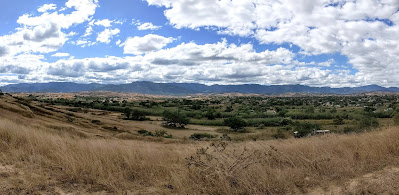












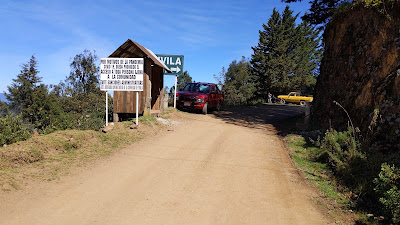







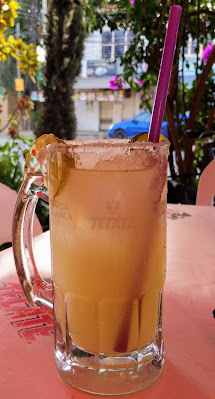

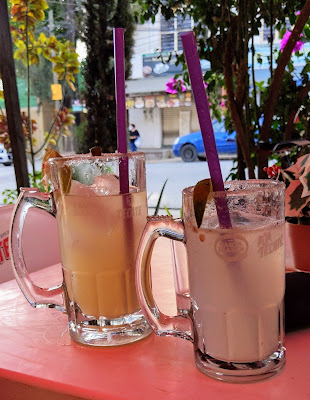













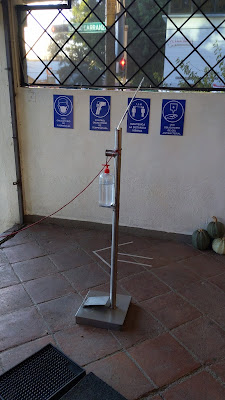











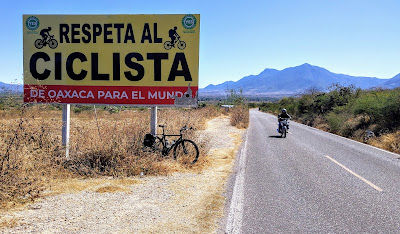


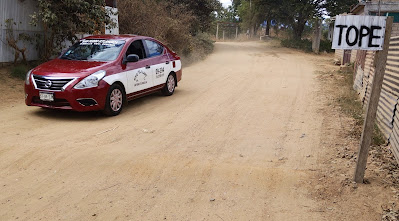



No comments:
Post a Comment